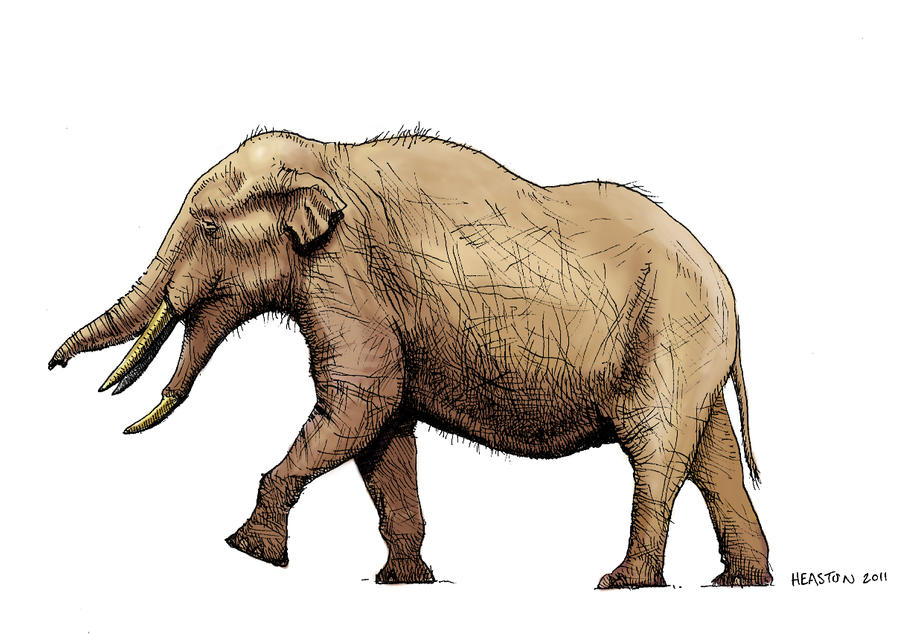Post by Infinity Blade on Apr 1, 2015 5:38:29 GMT 5
Platybelodon spp.

© @ pheaston
Temporal range: Miocene (15-4Ma)
Scientific classification:
Domain: Eukaryota
(unranked): Unikonta
(unranked): Opisthokonta
(unranked): Holozoa
(unranked): Filozoa
Kingdom: Animalia
Subkingdom: Eumetazoa
(unranked): Bilateria
Superphylum: Deuterostomia
Phylum: Chordata
Infraphylum: Gnathostomata
Clade: Eugnathostomata
Clade: Teleostomi
Superclass: Tetrapoda
Clade: Reptiliomorpha
Clade: Amniota
Clade: Synapsida
Clade: Eupelycosauria
Clade: Sphenacodontia
Clade: Sphenacodontoidea
Order: Therapsida
Suborder: Cynodontia
Clade: Prozostrodontia
Clade: Mammaliaformes
Class: Mammalia
Legion: Cladotheria
Sublegion: Zatheria
Infralegion: Tribosphenida
Subclass: Theria
Clade: Eutheria
Infraclass: Placentalia
Subcohort: Exafroplacentalia
Magnorder: Atlantogenata
Superorder: Afrotheria
Clade: Paenungulata
Order: Proboscidea
Superfamily: †Gomphotherioidea
Family: †Gomphotheriidae
Tribe: †Amebelodontini
Genus: †Platybelodon
Species: †P. danovi
†P. grangeri
†P. loomisi
†P. barnumbrowni
Platybelodon ("flat-spear tusk) is an extinct genus of proboscidean (namely a gomphothere, an extinct clade of aforementioned order) that lived in Africa, Eurasia, and North America during the Miocene epoch. Platybelodon is known for its unusual face and tusks. The lower jaw's distal end possessed two tusks that were more or less shaped like shovels, giving Platybelodon and any of its kin of similar morphology the nickname "shovel tuskers". It was initially believed that said tusks were utilized for scooping up aquatic plants, but Lambert (1992) inspected the wear patterns of the tusks and found that they were fulfilled a cutting function on tough vegetation (particularly tree bark). Likewise, the seemingly dorsoventrally-flattened proboscis commonly depicted in art is also inaccurate; morphological and functional evidence suggests that the probosces of the shovel tuskers were like those of extant proboscideans.[1]
References:
[1] "The feeding habits of the shovel-tusked gomphotheres: evidence from tusk wear patterns" (Lambert, 1992).

© @ pheaston
Temporal range: Miocene (15-4Ma)
Scientific classification:
Domain: Eukaryota
(unranked): Unikonta
(unranked): Opisthokonta
(unranked): Holozoa
(unranked): Filozoa
Kingdom: Animalia
Subkingdom: Eumetazoa
(unranked): Bilateria
Superphylum: Deuterostomia
Phylum: Chordata
Infraphylum: Gnathostomata
Clade: Eugnathostomata
Clade: Teleostomi
Superclass: Tetrapoda
Clade: Reptiliomorpha
Clade: Amniota
Clade: Synapsida
Clade: Eupelycosauria
Clade: Sphenacodontia
Clade: Sphenacodontoidea
Order: Therapsida
Suborder: Cynodontia
Clade: Prozostrodontia
Clade: Mammaliaformes
Class: Mammalia
Legion: Cladotheria
Sublegion: Zatheria
Infralegion: Tribosphenida
Subclass: Theria
Clade: Eutheria
Infraclass: Placentalia
Subcohort: Exafroplacentalia
Magnorder: Atlantogenata
Superorder: Afrotheria
Clade: Paenungulata
Order: Proboscidea
Superfamily: †Gomphotherioidea
Family: †Gomphotheriidae
Tribe: †Amebelodontini
Genus: †Platybelodon
Species: †P. danovi
†P. grangeri
†P. loomisi
†P. barnumbrowni
Platybelodon ("flat-spear tusk) is an extinct genus of proboscidean (namely a gomphothere, an extinct clade of aforementioned order) that lived in Africa, Eurasia, and North America during the Miocene epoch. Platybelodon is known for its unusual face and tusks. The lower jaw's distal end possessed two tusks that were more or less shaped like shovels, giving Platybelodon and any of its kin of similar morphology the nickname "shovel tuskers". It was initially believed that said tusks were utilized for scooping up aquatic plants, but Lambert (1992) inspected the wear patterns of the tusks and found that they were fulfilled a cutting function on tough vegetation (particularly tree bark). Likewise, the seemingly dorsoventrally-flattened proboscis commonly depicted in art is also inaccurate; morphological and functional evidence suggests that the probosces of the shovel tuskers were like those of extant proboscideans.[1]
References:
[1] "The feeding habits of the shovel-tusked gomphotheres: evidence from tusk wear patterns" (Lambert, 1992).



